Clinical Decision Making: Guide to Pass the MCCQE1 With Confidence

The Medical Council of Canada Qualifying Examination (MCCQE) part 1 exam is one of the qualification exams you will need to pass to become a certified physician in Canada. The exam is broken down into two parts, the Multiple-Choice Question (MCQ) and Clinical Decision Making (CDM). The CDM section, which is the last part of the MCCQE1 exam, evaluates your ability to make sound clinical decisions. The CDM section tests you on applying what you have learned in managing presented clinical cases. Most medical students and residents are often overwhelmed with the huge amount of information they need to remember. They are also often tempted to order unnecessary tests or treatments because it is difficult to resist the lure of trying to make the correct diagnosis. However, by extracting the most relevant information from each clinical case and having a good understanding of common medical presentations along with essential diagnosis procedures, you can avoid selecting unnecessary but super tempting diagnostic steps and management. This will help you to focus on the most important tasks and make sound decisions based on the best available evidence.
The clinical decision-making questions on the MCCQE1 are comprehensive, challenging and require a high level of attention to detail. The ability to scan fast through a clinical case and find relevant information is essential, but the key to success is your knowledge of the appropriate next clinical steps, management of life-threatening cases and Canadian screening protocol and guidelines.
There are many materials out there that talk about the MCCQE1 exam, but most of them will only focus on the MCQ part. In this article, we are going to mainly discuss the CDM part of the MCCQE1 exam in detail and share tips and the best way to prepare for this part of the MCCQE1 exam.
What Clinical Decision-Making Is All About?
Clinical decision-making is an important part of any medical encounter; it is a contextual, continuous, and evolving process by which healthcare providers apply their knowledge and experience with patients to make decisions about diagnosis, treatment, prognosis, and disposition. In general, clinical decision-making is a process of using gather information from the patient’s history, physical examination results, diagnostic tests (such as x-rays or blood tests), utilizing medical knowledge, and weighing the risks and benefits of every option against each other in order to make decisions about the diagnosis and treatment of patients. The good news is that clinical cases in the CDM part of the MCCQE1 exam will provide you with all the information you need, including the patient’s history, laboratory results, and clinical findings during physical examination.
The ability to make clinical decisions quickly and efficiently is one of the most critical skills that a healthcare professional can possess. The lack of skill can be attributed to the complexity of clinical situations, which often require making quick decisions based on incomplete information and lead to medical mistakes with devastating results that can disturb patients and their families.
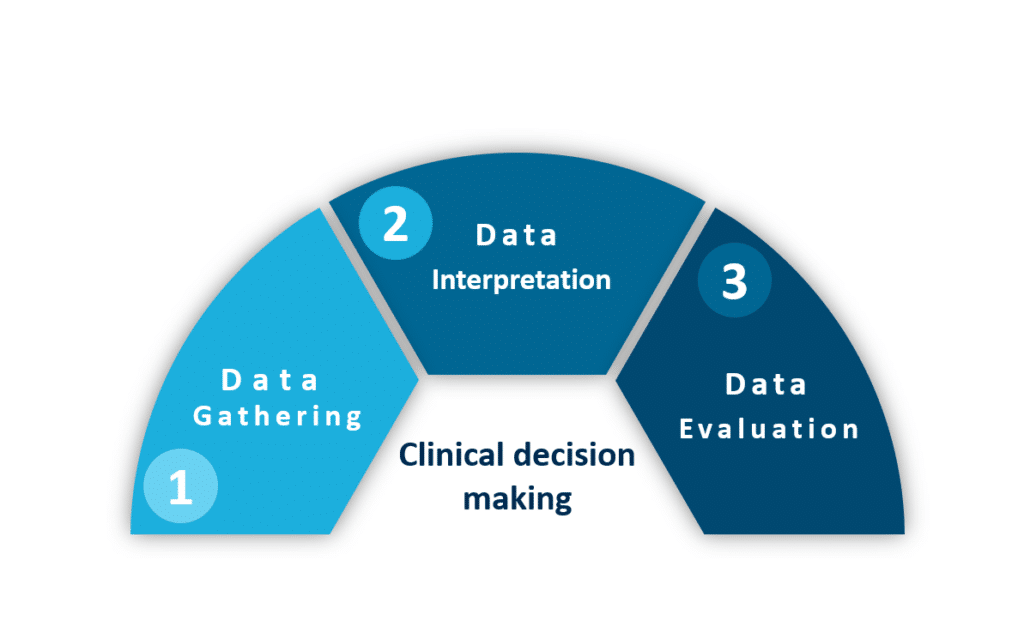
What Exactly Is The CDM Component Of MCCQE1?
The CDM section of the MCCQE1 is designed to assess the knowledge and skills of physicians who are assuming independent responsibility for providing general medical care to patients, emphasizing patient management in ambulatory settings. The exam consists of 38 cases, and you will have 3.5 hours to complete it. The CDM Part will focus on your ability to diagnose and manage conditions, with an emphasis on understanding how to use diagnostic tools and interpret relevant data to avoid ordering unnecessary diagnostic procedures and tailor the best management for the presented clinical case or virtual patient. In addition, the exam will assess your communication and interpersonal skills, your ethical code of conduct, and your ability to work within the healthcare system to ensure patient safety.
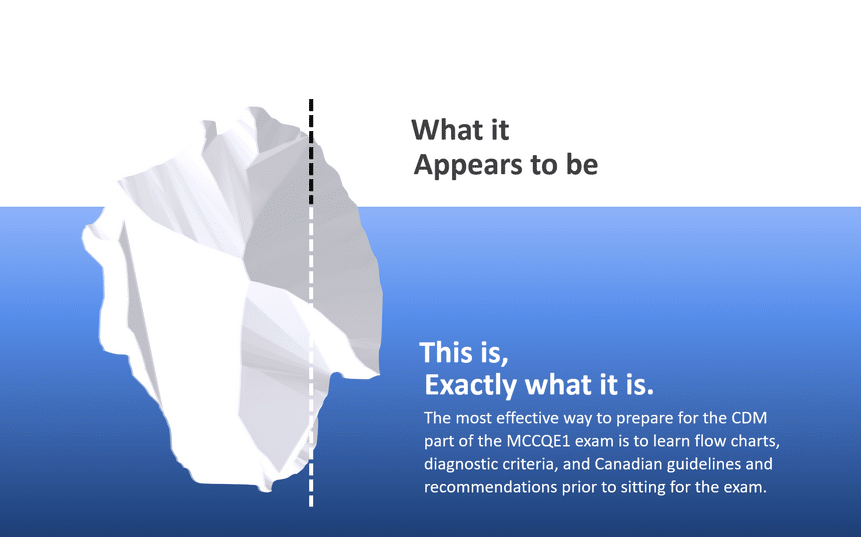
CDM cases are a vital part of the MCCQE1 exam. They assess your ability to apply the knowledge you have learned to real-life medical scenarios. It is a rookie mistake to underestimate the challenges that CDM may throw at you during the exam. The fact is that many students fail because they do not prepare well for the CDM component of the exam. Make sure you practice as many case studies as possible before sitting the exam. At Ace Qbank, we have designed questions of the question bank and clinical cases of the CDM part based on the MCC objectives and in support of one another. The flow charts, diagnostic criteria and Canadian guidelines and recommendations in the question bank provide the fundamental support for solving clinical cases in the CDM package of the Ace Qbank. Ace Qbank has done this to help with MCCQE1 exam preparation and to increase confidence and performance. Your performance is important to us because it fuels our creative engine and motivates us to do more of what we love and are passionate about.
Numer Of Cases Presented In The CDM?
CDM cases are not another question to answer in the MCCQE1 Exam, and underestimating them is a mistake. CDM part of the MCCQE Part 1 exam consists of 38 cases, each followed by 1-4 questions, which are either short-menu or short-answer write-in questions with specific instruction, which we will discuss in detail later on.
Each clinical case and question will appear on the same block, and you will have the option to scroll down horizontally to see all the answers. You might find photographs, diagrams, x-rays, and other visual material in some questions. CDM questions will also include the normal lab values, if necessary. You do not lose any points for answering questions incorrectly. Make sure you answer all of the questions correctly — there is no penalty for incorrect answers.
Time Allotted For The CDM Part
You will have up to three a half hours to answer and complete this section of the Exam.
Number Of Pilot Cases
Eight of the CDM cases are pilot cases that do not count toward your overall score; make sure you answer the questions all the way through – there is no penalty for wrong answers.
How important is the CDM part of MCCQE1?
CDM part of MCCQE part 1 is as equally important as the Multip;e-choice questions (MCQs) part of the exam even though, in comparison, the CDM part has 1/3 of the questions but the same amount of time. Often it is the number of questions followed by clinical cases and the amount of allotted time to complete the CDM part of the exam have most candidates fooled into believing that the CDM part is the most relaxing part of the entire MCCQE1 exam, and some candidates will even go the extra mile and assume CDM part plays a minor role. However, the result of the MCCQE1 exam will change all of these perspectives.
But why the CDM part of the MCCQE1 exam is important? The CDM component provides an assessment format that more closely mirrors clinical encounters and patient management than does the multiple-choice format. With concern for patient safety and quality of care, performing well on the CDM part is important, as the content of the CDM part focuses on the assessment of the ability to apply comprehensive knowledge of medicine in the context of patient management and the evolving manifestation of disease over time. It also assesses knowledge of history and physical examination, use of diagnostic investigations, and management, emphasizing prognosis and outcome, health maintenance, and health promotion.
The Purpose Of The CDM Part Of The MCCQE1 Exam
Here is the connection, the CDM section of the MCCQE1 Exam tests your clinical knowledge and clinical decision-making skills in continuous series of questions following the presented clinical case to make sure a candidate will make the best decision that meets the needs of the patient and good to practice with minimum or no supervision. Each question of a clinical case will provide further information that you need to interpret and evaluate in order to select correct answers from the options. So, your clinical skill, medical knowledge, and ability to follow specific instructions will be tasted in a virtual environment. Therefore, it’s crucial that you properly prepare for the CDM component of the MCCQE1 and that your decisions are based on real patient assessments.
If they see and treat it as a real-life scenario, you should not regard it as yet another question to answer.
Types Of Questions In CDM Part
In the CDM part of the MCCQE1 Exam, clinical cases are followed by two distinct types of questions:
- Short-menu questions
- short-answer write-in questions
1- Short-Menu Questions:
In short-menu questions, clinical cases are followed by question(s). The question includes precise instructions at the end and is followed by a short menu (list) of questions, which typically contains 10 to 14 options.
They are different types of instructions. Depending on the instructions at the end of the question, you may be asked to choose only one answer from the shortlist of options, up to a certain number of answers, or as many answers as appear appropriate.

2- Short-Answer Write-In Questions
In short-answer write-in questions, you will be asked to type in your answer. While you are typing the answer, make sure there are no spelling mistakes, clearly mention the route of administration of the medication, and don’t get into specifics; instead, use your common sense.
Don’t use the brand name of medications. The majority of drugs are available in both generic and brand names. The distinction between brand-name and generic drugs is found in the conditions under which the pharmaceuticals are manufactured. There are many pharmaceutical manufacturers across the world, and the same medication may have multiple brand names, but the generic name will never change. It is best to use a generic name of medication during the Exam to minimize any misunderstandings.
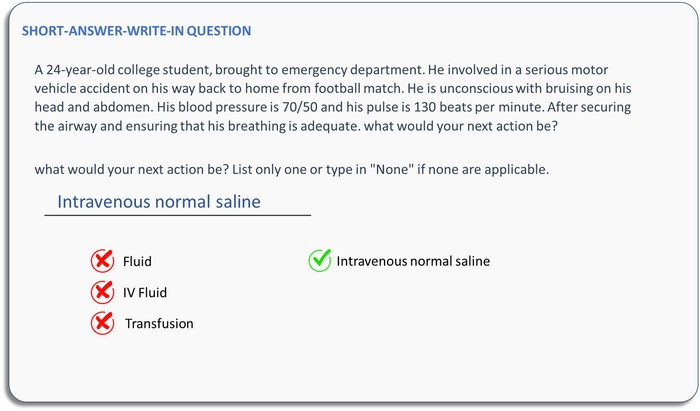
What Counts As One Answer In The Write-In Questions?
In Write-in questions of the CDM part of MCCQE1, you must write your responses. If a question allows you more than one response, write the one that best meets the needs of the patient in a clinical case. Please note that each answer will be counted as one response.
Many people know that they must write only “one” answer, but they are unsure what constitutes “one” response. Consequently, we gathered a few examples and created a shortlist. The following examples demonstrate what constitutes a “one” response:
- CBC and differential
- Liver enzymes (includes AST, ALT, GGT, ALP, bilirubin)
- LFT (bilirubin, INR, albumin)
- Cardiac enzymes (includes CK, TNI, TNT)
- Urinalysis (Urine R&M)
- Urine Culture & Sensitivity
- INR, PTT
- Lipids (includes LDL, HDL, total cholesterol, TG)
- Type & cross match
- FSH/LH
- Thyroid function (TSH only)
- Immunoglobulins
- Lumbar fluid analysis
- Gonorrhea/chlamydia
- Renal function (includes creatinine, eGFR, BUN/Urea)
How To Get The Appropriate Point Of CDM Cases?
Instruction at the end of questions is important and should not be taken lightly. Now that we know about instruction let’s talk about the consequences of failing to follow them.
Some instructions specify the exact number of responses you must select or type in, e.g., “List only one.” If you answer more than one response, you will receive a score of zero for the entire question, even if you selected the correct answer(s). In contrast, other instructions place a limit on the number of responses to be selected or typed in, e.g., “select up to X number.” Do not go above the specified number, but do not feel forced to choose or list up to that amount either. For example, the instruction may suggest that you can select up to six answers, yet there may only be three or five correct answers. If you choose six responses only to reach the maximum number of answers, you risk selecting incorrect answers. If you pick the wrong investigations or therapies, you will earn a zero on that question.
In certain cases, you will be asked to select as many responses as are appropriate responses. The number of the “correct” responses will be determined by you, which should reflect what you would do in a real-life clinical setting. This means that you shouldn’t pick too many answers in order to ensure that your answer comprises at least a modest fraction of correct answers.
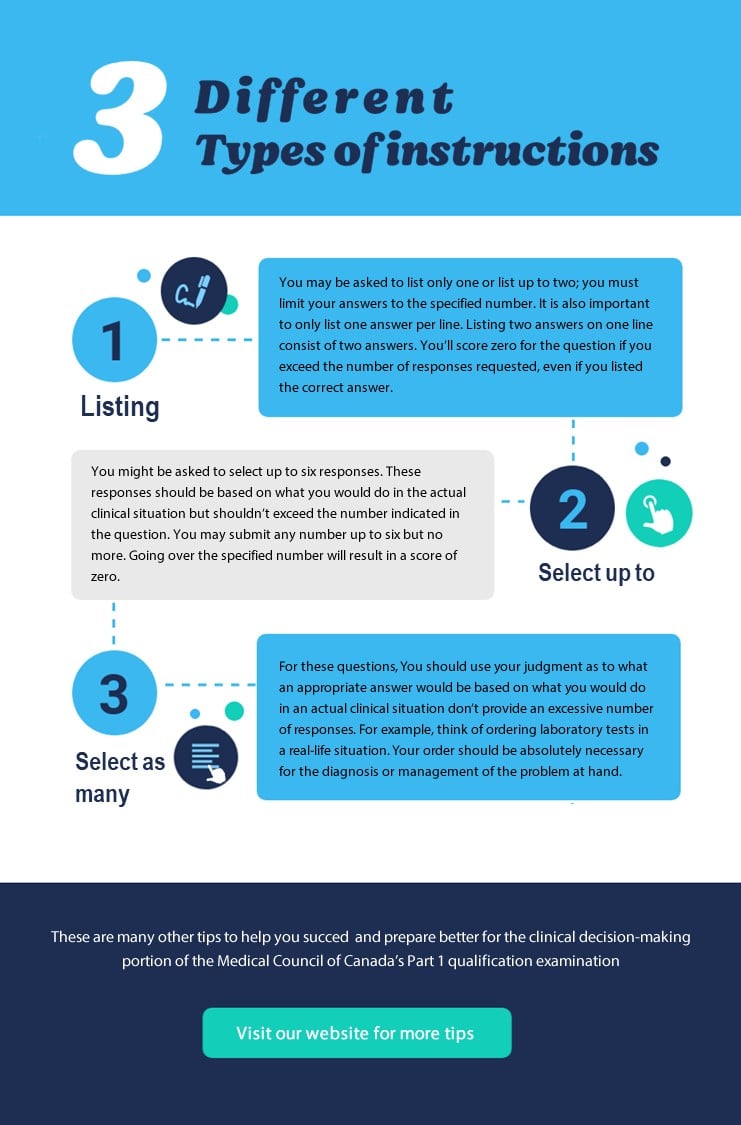
Zero Score IN CDM
Yes, you will earn a zero if the number of responses you submit in your answer exceeds the number specified in the question instruction or if you pick or list an item that might harm or injure a patient.
How To Approach The CDM Section?
The CDM component of the MCCQE1 examination has been the subject of much controversy for a number of years. Even though the MCCQE1 has been around for over a decade, the Exam still remains difficult for many candidates to pass. In fact, a large number of candidates have been sitting for this Exam for years without passing it.
For this reason, it is strongly advised to prepare and practice clinical cases for the CDM part prior to taking the Exam. Ace Qbank includes over 100 high-yield realistic clinical situations with a focus on patient management. The case-based approach was preferred to simulate a situation accurately on the MCCQE part 1 exam. The active-learning question-and-answer format following the patient presentation was selected to ensure the rapid comprehension of essential material needed to do well on the second part of the MCCQE1 Exam, based on recent evidence-based guidelines. Our objective is to reproduce the clinical decisions that a physician is required to make daily.
The Best Way To Approach The CDM Part
Ideally, you should approach CDM cases as clinicians, as you would in a hospital or clinic setting. This is the best way to approach the CDM cases. Think of an example from your clinical experiences, or if you are a new graduate, use examples from clerkship where you were able to help the patient. How would you decide for a patient in your care, and how would you respond in a certain type of emergency clinical situation?
Having well-organized clinical knowledge is quite beneficial in the medical field. The use of flow charts and diagnostic criteria will help in organizing clinical knowledge and, ultimately, make clinical decisions much easier. This clinical reasoning strategy is highly effective and works flawlessly every time. The best part is that Ace Qbank has incorporated many flow charts in the question bank to assist with this. For instance, a common symptom such as “sore throat” followed by a series of branches with “yes” or “no” questions about associated symptoms in flow charts. Is a fever present or not? Are cervical lymph nodes swollen? Have other family members suffered from the same symptom? Following the branches, all the way to the end lead to the proper diagnosis and therapy. In a clinical setting, a physician in charge has to gather all answers by asking the right question; however, the answers to those questions are provided for you in question stem of the clinical case but drawing an accurate conclusion from those answer need practice.
Most Effective Way To Prepare For The CDM
The most effective way to prepare for the CDM part of the MCCQE1 Exam is to learn flow charts, diagnostic criteria, and Canadian guidelines and recommendations embedded in the question bank, and then try to apply your knowledge to solve the clinical case in the CDM package. This is why the Ace Qbank premium package has question bank and CDM cases to facilitate preparation for the MCCQE1 Exam. Here at Ace Qbank, we have included many flow charts and diagnostic criteria in the question bank to assist you in preparing for both parts of the Exam and helping you organize your clinical thought, but it’s upon you to not take preparation for the MCCQE1 Exam lightly.
Many people can list the possible causes of a symptom, but they fail to separate important diagnostic features from the irrelevant details that many clinical cases throw at them. To manage clinical cases of CDM on the MCCQE1 Exam, you must employ an effective method of clinical reasoning, such as a flow chart, diagnostic criteria and Canadian guidelines and recommendations. The flow chart supplemented rather than replaced clinical skills and knowledge of individual disease conditions. It helps to reduce the cognitive burden and the chance of not considering the correct diagnosis. It serves as a scaffold to organize clinical knowledge.
Learn More About AceQbank CDM Cases
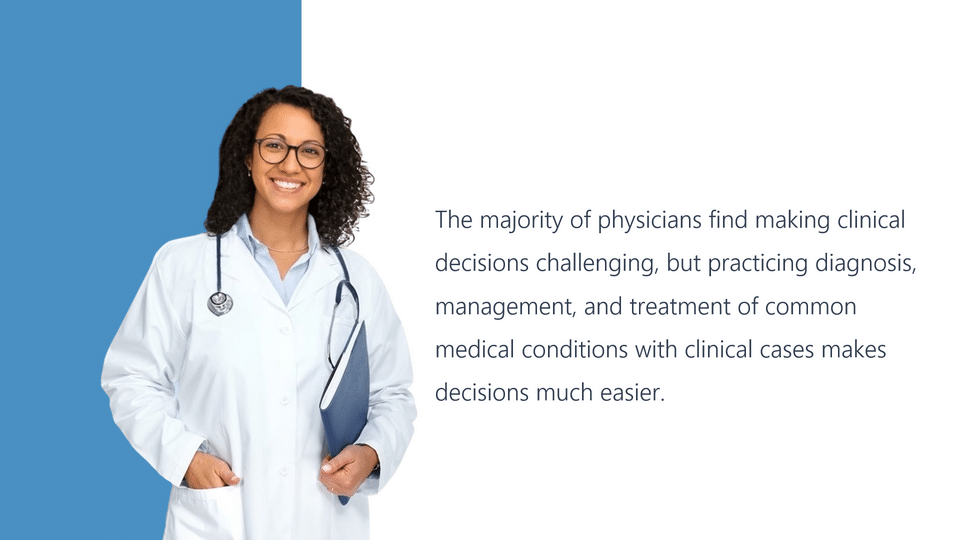
Test-Taking Tips For The CDM Section:
The CDM section of the MCCQE1 Exam is designed to test the medical knowledge, clinical skills, and abilities required for making safe and effective clinical decisions in practice management. Contrary to popular belief, the CDM component of the MCCQE1 is the most difficult to pass. It requires not only content knowledge but also critical thinking skills. This makes it hard for medical students who are not yet used to thinking critically about the cases they see on a daily basis. However, The most effective way to prepare for the CDM part of the MCCQE1 Exam is to learn flow charts, diagnostic criteria, and Canadian guidelines and recommendations prior to sitting for the Exam.
The CDM format is quite different from the MCQs part of the MCCQE1 Exam following five general tips are to help you better manage the CDM part of the Exam:
Time Your Break:
There will be only one flexible 45-minute break after the MCQs component in the morning, which you are in charge of tracking time. Each candidate enters the break at a different time because each applicant begins their MCCQE1 Exam at a different time due to the standard security scan and sign-in process, which can take between 3 and 5 minutes for each candidate before entering the Prometric room. As a result, if one does not pay attention to the time and gets carried away, it is easy to mistakenly exceed the 45-minute and shorten the time period of the CDM part of the Exam.
Look For Relevant Information:
Patient history, everything presented in the clinical case, and questions are relevant, and you should pay attention to the details. Since clinical decision-making is a continuous and evolving process, healthcare providers apply their knowledge and experience with patients to make decisions about diagnosis, management, and treatment. The CDM section of the MCCQE1 Exam tries to simulate the real-life situation and tests the candidate’s clinical skills in continuous series of questions following the presented clinical case. Each question will provide further information that you need to interpret and evaluate in order to select correct answers from their options.
Make Sure You Read The Instruction:
Follow the instructions to succeed in the Exam. You need to follow instructions when you are selecting the correct answer; one of the most important aspects of this part of the MCCQE1 Exam is to follow the instructions precisely. In the Exam, you will also be tested on your ability to follow directions, and if the CDM question asks for a specific number of responses, don’t go beyond that amount. Even if the right answer is included, you will receive a zero for this question. You must strictly adhere to the instructions.
Don’t Bog Down With Specifics:
Know what counts as one answer. In short-answer write-in questions, you need to know what qualifies as one response. So, if a CDM question requires you to provide only one answer, be sure you only fill in one. Even if the right answer is included, writing more than one answer will result in a score of zero. “Airway assessment,” for example, would be one response, whereas “airway, breathing, and circulation (ABCs)” would be three.
Manage Your Time:
The MCCQE Part 1 is a timed exam. Many will underestimate the CDM part of the MCCQE1 Exam, lower their guard and relax. They make this mistake because they think in terms of numbers. The CDM section contains only 70 questions, and they have three and a half hours to answer them all, which makes sense mathematically, but the fact is that each of those questions has up to 14 options that you need to read and either eliminate or select it as a correct answer based on the information you gathered from the clinical case and the questions instruction.
Make sure you grasp the clinical case clues on the first read; otherwise, re-reading the clinical case and analyzing all 10 to 14 options all over again will take a significant amount of time.
No, Negative Score:
CDM scoring is also important. Before taking the Exam, you should understand how it is graded. There are no negative points; you either earn one point for being correct or zero if you are incorrect. When more than one answer is assessed, partial marks are granted. Additionally, you will earn a zero if the number of responses you submit in your answer exceeds the number specified in the question instruction or if you pick or list an item that might harm or injure a patient.
Read The Full Blog: Insight Into The MCCQE1 Exam
In summary, from the above, we can see that clinical decision-making is a complex process, with multiple considerations and many different approaches. To be successful and pass the MCCQE1 Exam, you must be able to swiftly analyze clinical cases, read the question instruction, and select the best options. The best way to practice for the CDM component of the MCCQE 1exam is to use Ace Qbank 100+ high yield CDM since it is designed based on the MCC objectives, and you can find the corresponded objective in the reference section with a reference for further study. This is the ultimate CDM resource, and using it is a great way to learn and overcome CDM obstacles.
Need Help With Your MCCQE1 Exam Preparation?
Proper preparation is essential for success on the MCCQE1 Exam, and you should make every effort to earn the maximum possible score on the MCCQE1 Exam. If you’re having trouble keeping to your study plan or if certain objectives are challenging for you, get the help you need to pass the MCCQE1 Exam on the first attempt.
Ace Qbank has got your back with over 2000+ high yield questions, many Clinical Decision-Making (CDM) cases, and several self-assessments available to challenge and push you to your limit.
To facilitate preparation for the MCCQE1 Exam, we developed the Ace Qbank based on the Medical Council of Canada (MCC) objectives. Our team reviews the question bank regularly based on current guidelines and recommendations, and we implement any changes we make as soon as possible to enhance your learning experience. Our objective is to keep the information up to date and in compliance with medical standards of care to avoid surprises during the test. At Ace Qbank, we’ve got you covered.
We invite you to sign up for the Ace Qbank demo today and see the difference our elite question bank makes!


